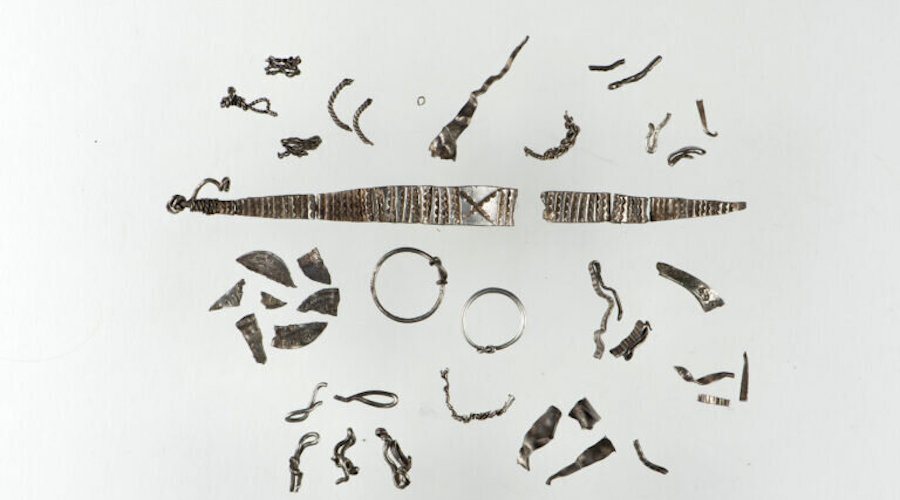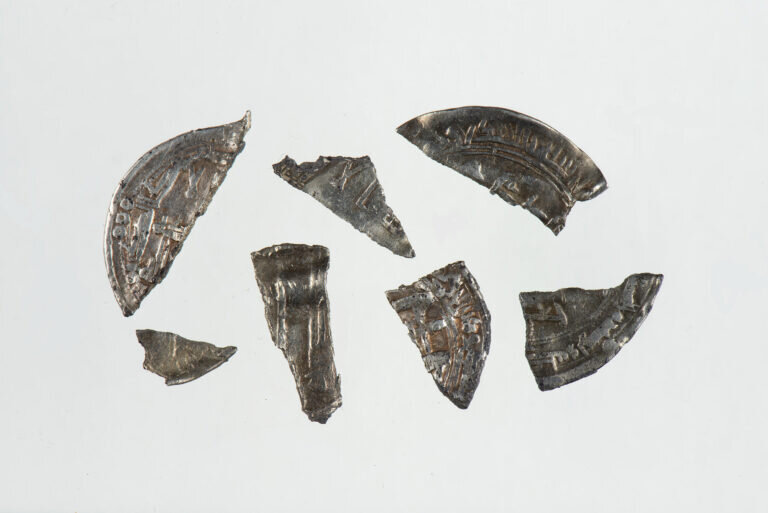Metal detectorist finds Viking Age silver treasure

An accidental finding made by a citizen tinkling around with a metal detector in central Norway turned out to be a treasure from the Viking Age.
While exploring a plot of land at the Kongshaug plateau in Stjørda on a winter day, Pawel Bednarski found a trove of 46 silver objects.
The objects are almost exclusively fragments. Apart from two simple, complete finger rings, they include Arab coins, a braided necklace, several bracelets and chains, all cut into small pieces—also called hacksilver.
“This find is from a time when silver pieces were weighed and used as means of payment. This system is called the weight economy and was in use in the transitional period between the earlier barter economy and subsequent coin economy,” said archaeologist and researcher Birgit Maixner, who was asked by Bednarski to analyze the pieces.
Maixner, who works at the University Museum of the Norwegian University of Science and Technology, explained that on the Continent and in Western Europe, coins started to be used as early as the Merovingian period (approx. 550–800 CE), but it was only towards the end of the Viking Age—late in the 9th century—that coins began to be minted in Norway. Up until the Viking Age, a barter economy was common in the Nordic countries, but by the end of the 8th century, the weight economy was making inroads.
“The weight economy was a much more flexible system than the barter economy. In the barter economy, for example, you had to have a fair number of sheep if you wanted to exchange them for a cow. Weighed silver, on the other hand, was easy to handle and transport, and you could buy the goods you wanted when it worked for you,” the researcher noted.
Exchanging silver for cows
The 46 pieces of silver weigh a total of 42 grams, meaning they could have been worth about six-tenths of a cow, based on clues extracted from the Gulating law.
“That treasure amount was worth quite a lot in its time, especially for one individual—and also when you realize it wasn’t that long ago that medium-sized farms with five cows became common,” Maixner said. “We don’t know if the owner hid the silver for safekeeping—and then was prevented from retrieving it—or if it was buried as a sacrifice or a gift to some god.”
Most of the pieces of silver that were found weighed less than one gram, which suggests that they were used repeatedly as means of payment. That the owner might have been involved in trading is, thus, a reasonable conjecture.
According to Maixner, typical for Scandinavian treasure troves from the Viking Age is that they contain a fragment of each object. This find, however, contains several pieces of the same type of artifact. For example, the find contains an almost complete armband, divided into eight pieces. Broadband bangles of this type are thought to have been created in Denmark in the 9th century.
“We can see that the owner prepared himself for trading by dividing the silver into appropriate weight units. The person in question had access to complete broadband bracelets, a primary Danish object type, which could indicate that the owner was in Denmark before travelling up to the Stjørdal area,” the archaeologist said.

Another unusual feature is the age of the Arab coins. Typically, about three-quarters of the Islamic coins in Norwegian finds from the Viking Age were minted between 890 and 950 CE. Only four out of seven coins from this find have been dated, but they stem from the late 700s or early 800s to later in the 9th century.
“The relatively high age of the Islamic coins, the broadband armbands and the large degree of fragmentation of most of the objects are more typical of finds from Denmark than from Norway. These features also make it reasonable to assume that the artifacts stem from around 900 CE,” Maixner pointed out.
Previous studies have shown that the Kongshaug plateau had a very strategic location on the north-south road at the entrance to the Stjørdal region, which in itself was an important trade route between the east and the west.
“Finds of weights and Viking Age coins on the plain within the river meander and at the Husby farm indicate that trading activities took place in this area. A Viking Age grave find from the Moksnes farm—which included a bowl scale to weigh silver among the artifacts found there—confirms this,” Maixner said.
“Perhaps the owner of the silver treasure found the trading post unsafe and hid his valuables in the entrance area to the plain, on the Kongshaug plateau. Here it remained until Pawel Bednarski found it plowed up in a furrow around 1,100 years later.”
More News
Ontario promises to cut red tape for critical mining projects
April 17, 2025 | 01:48 pm
MP Materials halts exports to China
The move follows Chinese restrictions announced earlier this month.
April 17, 2025 | 01:32 pm
China’s aluminum makers say tariffs won’t deter overseas growth
April 17, 2025 | 01:24 pm
GDX’s gold pursuit quickens
The dominant gold-miners ETF’s catch-up rally with gold is really accelerating.
April 17, 2025 | 11:24 am
{{ commodity.name }}
{{ post.title }}
{{ post.date }}





Comments